The 78S40 is not one of the most modern switching regulators, together with its small brother the MC34063 it dates back to the 1990’s. It differs from the 34063 by having an additional, uncommitted operational amplifier inside its 16-pin package. There are many application notes available, since both chips are manufactured by several companies. There is also a great online calculator to dimension the 34063 in its three basic configurations: buck (higher voltage down to lower voltage), boost (lower voltage to higher voltage) and inverter (positive voltage to negative voltage: http://www.nomad.ee/micros/mc34063a/index.shtml.
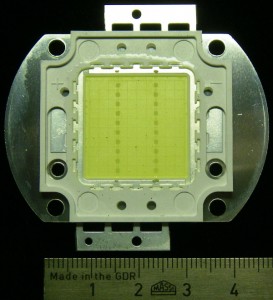
I recently purchased a single 20W white LED on eBay. On the 2cm by 2cm large active area there are two parallel strings of 10 individual blue LED chips, embedded in a soft transparent silicone with a yellow phosphor. The series connection of 10 blue LEDs leads to a forward voltage drop of ca 35 V at the operating current of 700 mA. Lacking a suitable lab power supply I had to first built a power supply in order to light up this LED. As with all LEDs the device should be operated from a constant-current source because of its exponential current-voltage characteristics.
Still the basic configuration of a switch-mode power supply using an MC34063 or 78S40 feeds back the output voltage through a resistive voltage divider, formed by R2 and R3 in the circuit below, the maximum output voltage is limited to 40 V.
In order to build a switch-mode constant-current source you need to monitor and feed back the current through the load. The simplest way to monitor the current is by means of a shunt resistor between ground and the load, where the voltage over the shunt resistor (R4 in the schematic below) is proportional to the current through the load.
Since many switch-mode power controller chips use an internal reference voltage of about 1.25 V, you would loose a lot of power in the shunt resistor without any additional amplification of the signal, in this example with a diode current of 700 mA the power loss would be almost 1 W or 5% of the desired output power.
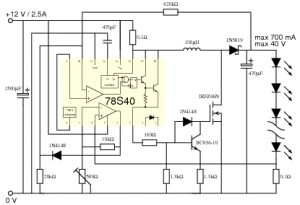
But here the additional operational amplifier within the 78S40 comes in handy. It can be used to boost the much smaller voltage drop over a much smaller shunt resistor. I chose a shunt resistor of 0.1 Ω, resulting in a power loss of merely 0.05 W at 700 mA. At working current the voltage drop over the shunt resistor is thus 70 mV. Resistors R5 and R6 set the amplification of a non-inverting amplifier, R6 is adjustable in order to trim the current through the LED to exactly 700 mA. The opamp’s output signal needs to be the reference voltage of the controller chip plus the forward voltage drop of diode D4 of about 0.6 V. If the opamp output reaches this value it overrides the voltage feedback signal at pin 10 of the 78S40 and thus the controller goes into current regulation.
In order to be able to switch the necessary current for this boost converter through the inductor L1, an external switching transistor is needed. The application notes show examples with bipolar transistors, but I went for a drive circuit and a power MOSFET Q2, derived from a circuit shown in the datasheet of the MC34063 from ST. After simulating the circuit in LTspice, I built it first on a breadboard and then on a piece of perfboard.
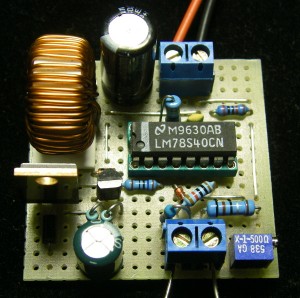
…and it works!!!
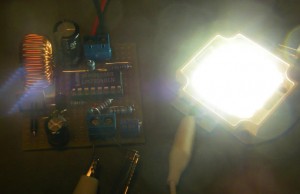
How good does it work? At 700 mA LED current and 32 V of output voltage over the LEDs, derived from an input voltage of 12 V, I measured an electrical conversion efficiency of 85%. No world record, but ok for now… I will further investigate where the remaining 15% of power are lost. The inductor gets slightly warm, so I suspect core losses or saturation…
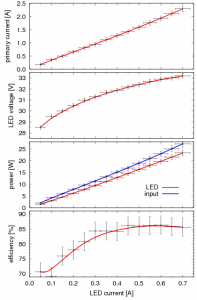

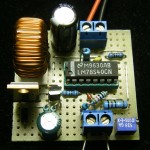
hi there, any update on this article of yours. thank you
…are you missing anything?
Uwe.